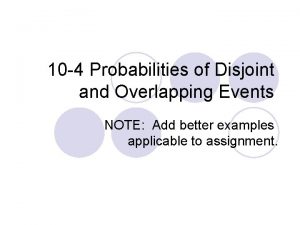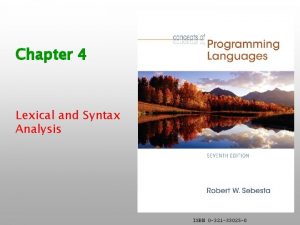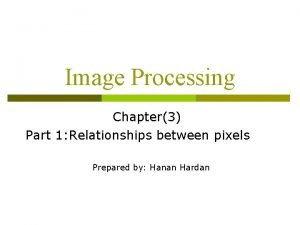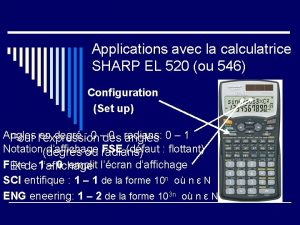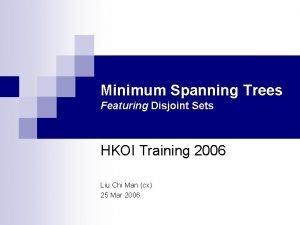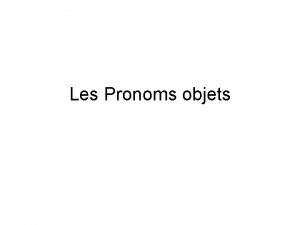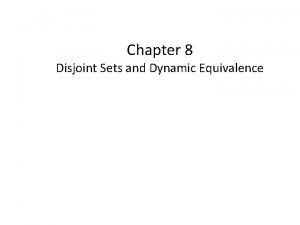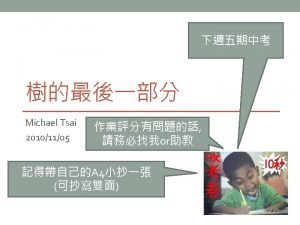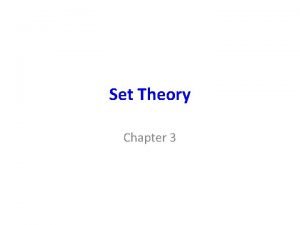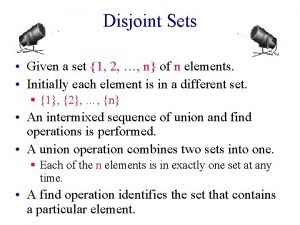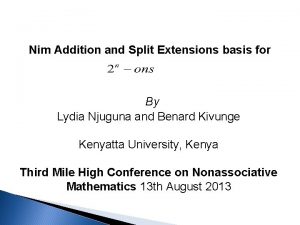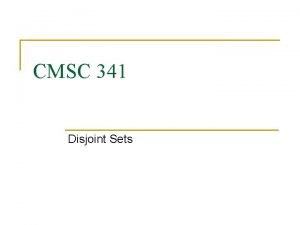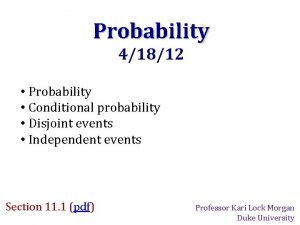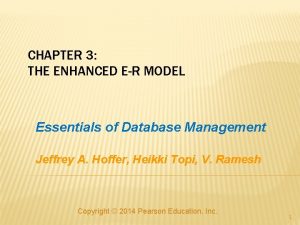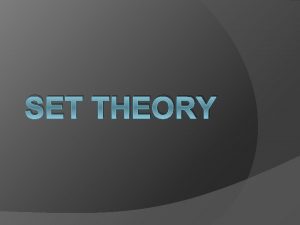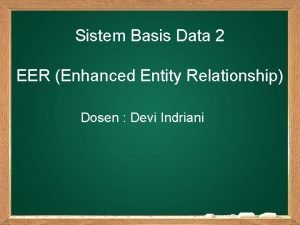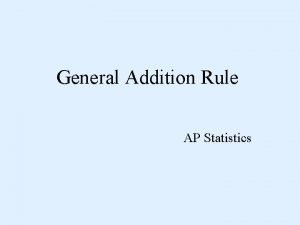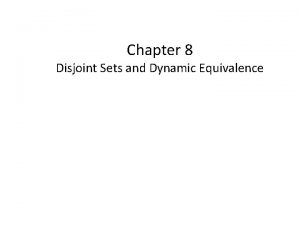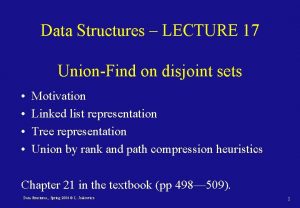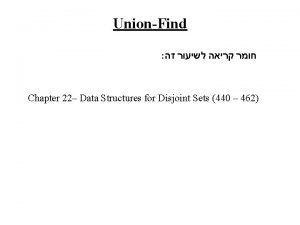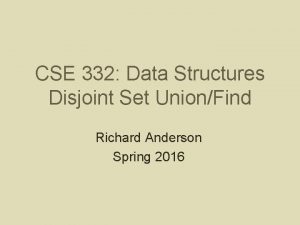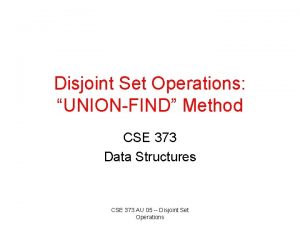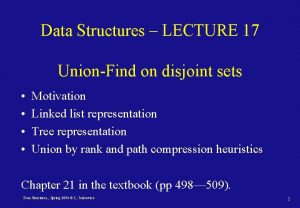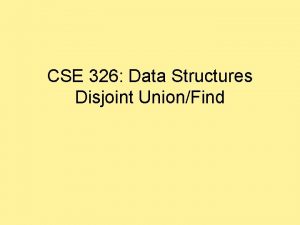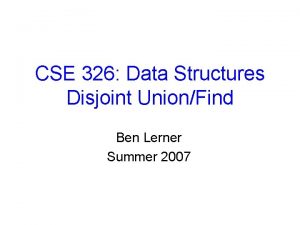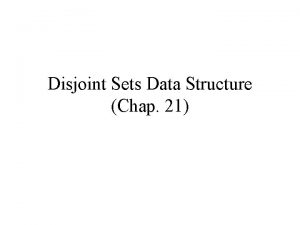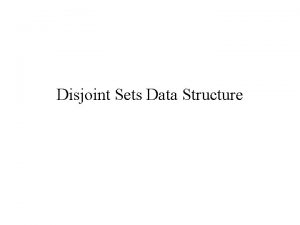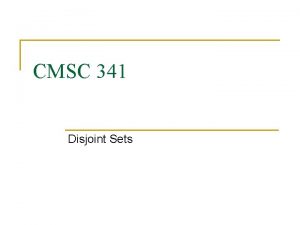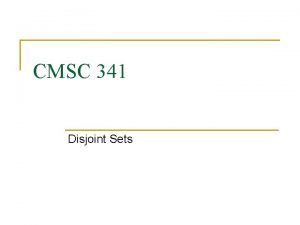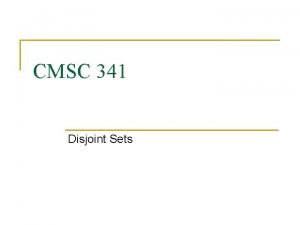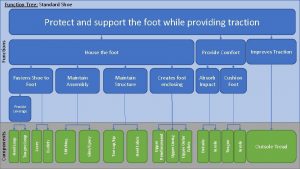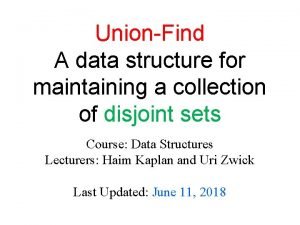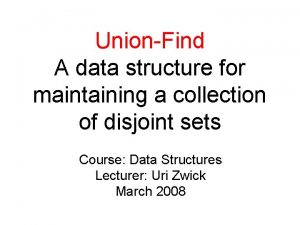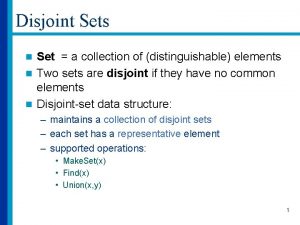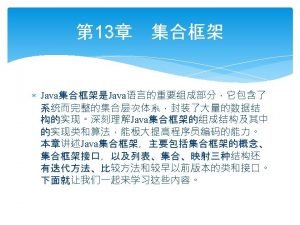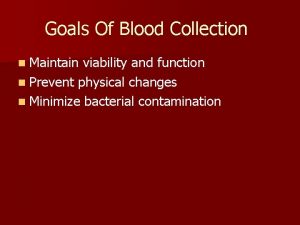Unionfind 1 Unionfind Maintain a collection of disjoint

























- Slides: 25

Union-find 1

Union-find • Maintain a collection of disjoint sets under the following two operations • S 3 = Union(S 1, S 2) • Find(x) : returns the set containing x 2

Union-find • We assume there are n fixed elements • We start with n sets each containing a single element • Each element has a pointer to its representation in the set containing it 3

S 1 = {e 1} S 2 = {e 2} S 3={e 3} S 4={e 4} …… A = Union(S 3, S 4) S 1 = {e 1} A= {e 2, e 3} S 4={e 4} …… Find(e 2) A B = Union(A, S 7) S 1 = {e 1} B= {e 2, e 3, e 7} S 4={e 4} …… 4

Why ? • Suppose we want to maintain an equivalence relation: y z b v t x s a y≡z 5

y, z t x b v s a y≡s 6

y, z, s t b x v a y≡s 7

Queries • Equivalent? (y, a) 8

Can solve this with union-find • Each equivalence class is a set • y ≡ s union(find(y), find(s)) • Equivalent? (y, a) return yes if find(y) = find(a) 9

Representation • Represent each set by a tree, each node represents an item, the root also represents the set B e 2 e 7 e 3 10

Concretely B e 2 e 7 e 3 11

Find(e 10) C e 6 e 9 e 11 e 10 e 8 12

Find(e 10) C e 6 e 9 e 11 e 10 e 8 Find(x) while (x. parent ≠null) do x ← x. parent return (x) 13

D=Union(B, C) C e 6 e 2 B e 7 e 3 e 9 e 11 e 10 e 8 14

D=Union(B, C) C e 6 e 2 B e 7 e 3 e 9 e 11 e 10 e 8 15

D=Union(B, C) D e 6 e 2 B e 7 e 3 e 9 e 11 e 10 e 8 16

D=Union(B, C) e 2 B e 7 C e 6 e 3 e 9 e 11 e 10 e 8 17

D=Union(B, C) e 2 B e 7 C e 6 e 3 e 9 e 11 e 10 e 8 18

D=Union(B, C) e 2 D e 7 C e 6 e 3 e 9 e 11 e 10 e 8 19

Link by size • For the find’s sake its better to hang the smaller on the larger 20

D=Union(B, C) C e 6 5 3 e 2 B e 7 e 3 e 9 e 11 e 10 e 8 If (C. size > B. size) then B. Parent ← C; C. size = C. size + B. size return (C) Else C. parent ← B; B. size = B. size + C. size return (B) 21

D=Union(B, C) D C e 6 8 3 e 2 B e 7 e 3 e 9 e 11 e 10 e 8 If (C. size > B. size) then B. Parent ← C; C. size = C. size + B. size return (C) Else C. parent ← B; B. size = B. size + C. size return (B) 22

Analysis • Union: O(1) time • Find: O(log(n)) time • The depth of a tree is at most log(n) 23

Proof By induction on the sequence of operations: For every x Depth(x) ≤ log |T(x)| x 24

Path compression 25
 Disjoint events probability
Disjoint events probability Pairwise disjointness test
Pairwise disjointness test A collection of utility programs designed to maintain
A collection of utility programs designed to maintain Sightd
Sightd Landsat collection 1 vs collection 2
Landsat collection 1 vs collection 2 The distance between pixels p and q
The distance between pixels p and q Sharp el-520
Sharp el-520 Kompozycja ponad dziedziczenie
Kompozycja ponad dziedziczenie Hkoi
Hkoi Pronom disjoint
Pronom disjoint Disjoint
Disjoint Disjoint maze
Disjoint maze Disjoint set adt
Disjoint set adt Slidetodoc
Slidetodoc Linked list representation of disjoint sets
Linked list representation of disjoint sets Roster notation example
Roster notation example Les pronoms personnels conjoints
Les pronoms personnels conjoints Disjoint set adt
Disjoint set adt Nim split string
Nim split string Disjoint set definition and example
Disjoint set definition and example Phomosexual
Phomosexual Overlap rule example
Overlap rule example Improper subset
Improper subset Contoh diagram eer
Contoh diagram eer Stats general addition rule
Stats general addition rule Smart union algorithm in data structure
Smart union algorithm in data structure
